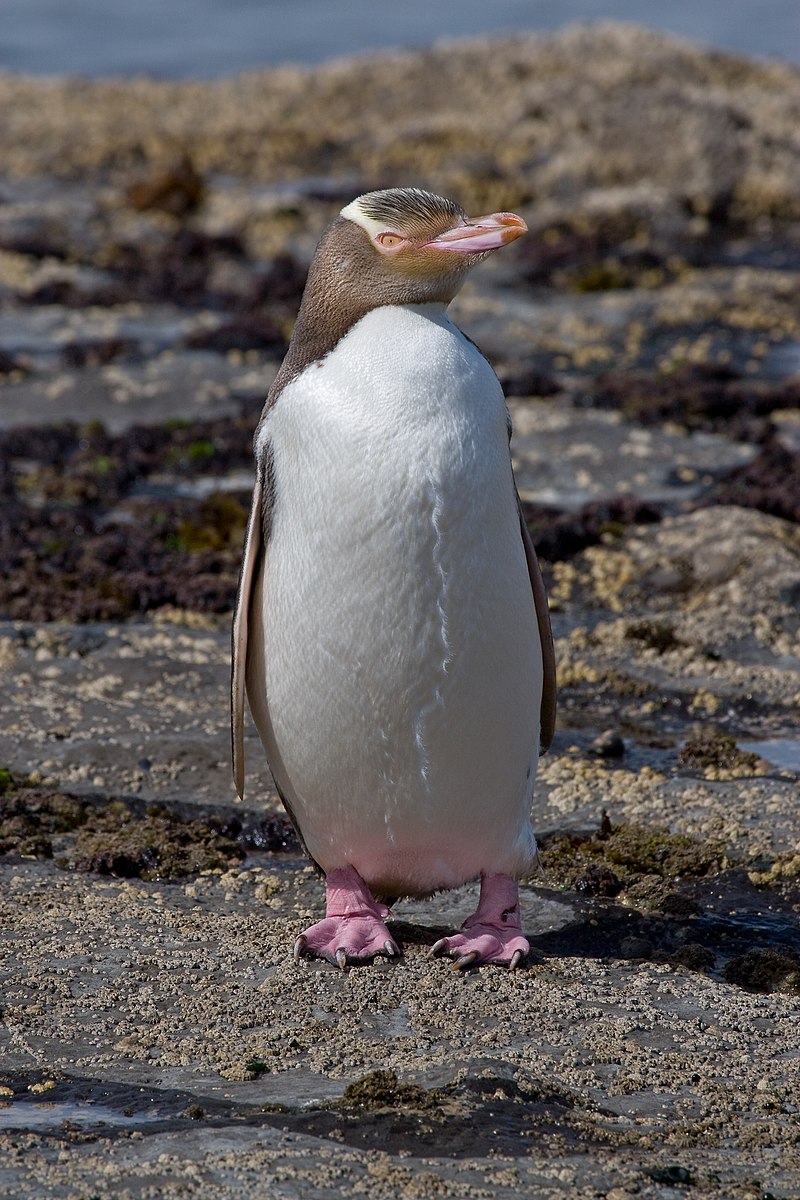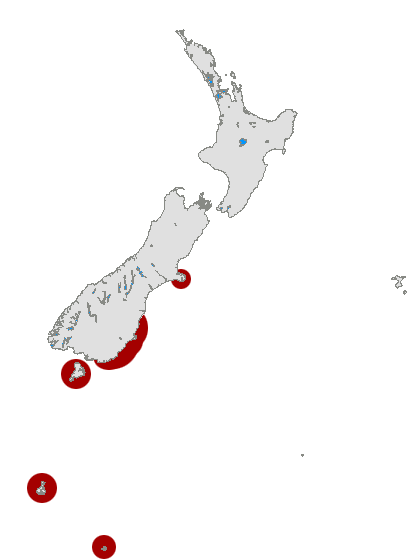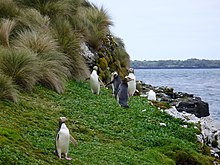The species breeds along the eastern and south-eastern coastlines of the South Island of New Zealand, as well as Stewart Island, Auckland Islands, and Campbell Islands. Colonies on the Otago Peninsula are a popular tourist venue, where visitors may closely observe penguins from hides, trenches, or tunnels.
On the New Zealand mainland, the species has experienced a significant decline over the past 20 years. On the Otago Peninsula, numbers have dropped by 75% since the mid-1990s and population trends indicate the possibility of local extinction in the next 20 to 40 years. While the effect of rising ocean temperatures is still being studied, an infectious outbreak in the mid 2000s played a large role in the drop. Human activities at sea (fisheries, pollution) may have an equal if not greater influence on the species' downward trend.[2]

Taxonomy
The yellow-eyed penguin is the sole extant species in the genus Megadyptes. (A smaller, recently extinct species, M. waitaha, was discovered in 2008.[3]) Previously thought closely related to the little penguin (Eudyptula minor), new molecular research has shown it more closely related to penguins of the genus Eudyptes. Mitochondrial and nuclear DNA evidence suggests it split from the ancestors of Eudyptes around 15 million years ago.[4]The yellow-eyed penguin was described by Jacques Bernard Hombron and Honoré Jacquinot in 1841. The Māori name is hoiho.
Description
This is a mid-sized penguin, measuring 62–79 cm (24–31 in) long (fourth largest penguin). Weights vary through the year being greatest, 5.5 to 8 kg (12–18 lbs), just before moulting and least, 3 to 6 kg (6.6–13.2 lbs), after moulting. The males are larger than the females.[5][6] It has a pale yellow head and paler yellow iris with black feather shafts. The chin and throat are brownish-black. There is a band of bright yellow running from its eyes around the back of the head. The juvenile has a greyer head with no band and their eyes have a grey iris.The yellow-eyed penguin may be long lived, with some individuals reaching 20 years of age. Males are generally longer lived than females, leading to a sex ratio of 2:1 around the age of 10–12 years.[7]
Distribution and habitat
Juvenile in The Catlins, New Zealand
Health
Calling at Curio Bay, New Zealand
Foraging behaviour
The yellow-eyed penguin forages predominantly over the continental shelf between 2 km (1 mi) and 25 km (16 mi) offshore, diving to depths of 40 m (131 ft) to 120 m (394 ft) [10][11] Breeding penguins usually undertake two kinds of foraging trips: day trips where the birds leave at dawn and return in the evening ranging up to 25 km from their colonies, and shorter evening trips during which the birds are seldom away from their nest longer than four hours or range farther than 7 km.[11] Yellow-eyed penguins are known to be an almost exclusive benthic forager that searches for prey along the seafloor. Accordingly, up to 90% of their dives are benthic dives.[11] This also means that their average dive depths are determined by the water depths within their home ranges.[12]Diet
Around 90% of the yellow-eyed penguin's diet is made up of fish, chiefly demersal species that live near the seafloor (e.g. blue cod (Parapercis colias), red cod (Pseudophycis bachus), opalfish (Hemerocoetes monopterygius) [13]). Other species taken are New Zealand blueback sprat (Sprattus antipodum) and cephalopods such as arrow squid (Nototodarus sloanii). Jellyfish including species in the genera Chrysaora and Cyanea were found to be actively sought-out food items, while they previously had been thought to be only accidentally ingested. Similar preferences were found in the Adélie penguin, little penguin and Magellanic penguin.[14]Breeding
On the shore of Enderby Island, Auckland Islands
A family of yellow-eyed penguin
First breeding occurs at three to four years of age and long term partnerships are formed.
Penguins and humans
Conservation
This species of penguin is endangered, with an estimated population of 4000. It is considered one of the world's rarest penguin species. The main threats include habitat degradation and introduced predators. It may be the most ancient of all living penguins.[15]A reserve protecting more than 10% of the mainland population was established at Long Point in the Catlins in November 2007 by the Department of Conservation and the Yellow-eyed Penguin Trust.[16][17]
In August 2010, the yellow-eyed penguin was granted protection under the U.S. Endangered Species Act.[18]
Tourism
Several mainland habitats have hides and are relatively easily accessible for those wishing to watch the birds come ashore. These include beaches at Oamaru, Moeraki light-house, a number of beaches near Dunedin, and The Catlins. In addition, commercial tourist operations on Otago Peninsula also provide hides to view yellow-eyed penguins.In culture
- The hoiho appears on the reverse side of the New Zealand five-dollar note.
- The yellow-eyed penguin is the mascot to Dunedin City Council's recycling and solid waste management campaign.[19]
- The yellow-eyed penguin is also featured in Farce of the Penguins, in which they complain about global warming.
(Hombron & Jacquinot, 1841)

Distribution of Yellow-eyed penguin





No comments:
Post a Comment
Note: Only a member of this blog may post a comment.